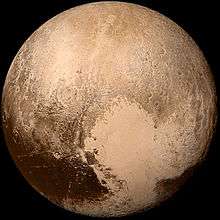(471288) 2011 GM27
| Discovery[1] | |
|---|---|
| Discovery site | La Silla Obs. (809) |
| Discovery date | 2 April 2011 |
| Designations | |
| MPC designation | 2011 GM27 |
| TNO · cubewano | |
| Orbital characteristics[2] | |
| Epoch 13 January 2016 (JD 2457400.5) | |
| Uncertainty parameter 4 | |
| Observation arc | 3308 days (9.06 yr) |
| Aphelion | 45.277 AU (6.7733 Tm) |
| Perihelion | 42.628 AU (6.3771 Tm) |
| 43.953 AU (6.5753 Tm) | |
| Eccentricity | 0.030132 |
| 291.40 yr (106434 d) | |
| 70.965° | |
| 0° 0m 12.177s /day | |
| Inclination | 13.033° |
| 257.17° | |
| 214.93° | |
| Earth MOID | 41.6532 AU (6.23123 Tm) |
| Jupiter MOID | 37.4516 AU (5.60268 Tm) |
| Physical characteristics | |
| Dimensions | 446 km (assumed)[3] |
| 0.06 (assumed)[3] | |
| 5.2[2] | |
|
| |
(471288) 2011 GM27 is a trans-Neptunian object (TNO) in the Kuiper belt. It orbits slightly outside a 3:5 resonance with Neptune, taking 16 years (5.5% of its orbit) longer to orbit the Sun than a body in 3:5 resonance. It was discovered on 2 April 2011 at ESO's La Silla Observatory in Chile. With an absolute magnitude of 5.2,[2] it is probably a dwarf planet, as its diameter has been roughly estimated to be about 450 kilometers based on an assumed geometric albedo of 0.06.[3] It has a Tisserand's parameter relative to Jupiter of 5.771.[2] Precovery observations exist dating back to 2006 in SDSS data.[4]
References
- ↑ "2011 GM27". Minor Planet Center. Retrieved 23 October 2015.
- 1 2 3 4 "JPL Small-Body Database Browser: (2011 GM27)" (2015-01-28 last obs.). Jet Propulsion Laboratory. Retrieved 31 March 2016.
- 1 2 3 Michael E. Brown. "How many dwarf planets are there in the outer solar system? (updates daily)". California Institute of Technology. Archived from the original on 2011-10-18. Retrieved 2012-08-31.
- ↑ "On the discovery and precovery of Trans-Neptunian Objects from SDSS images". talk.galaxyzoo.org. pp. 1–2. Retrieved 8 March 2015.
External links
This article is issued from Wikipedia - version of the 9/3/2016. The text is available under the Creative Commons Attribution/Share Alike but additional terms may apply for the media files.
_(cropped).jpg)
